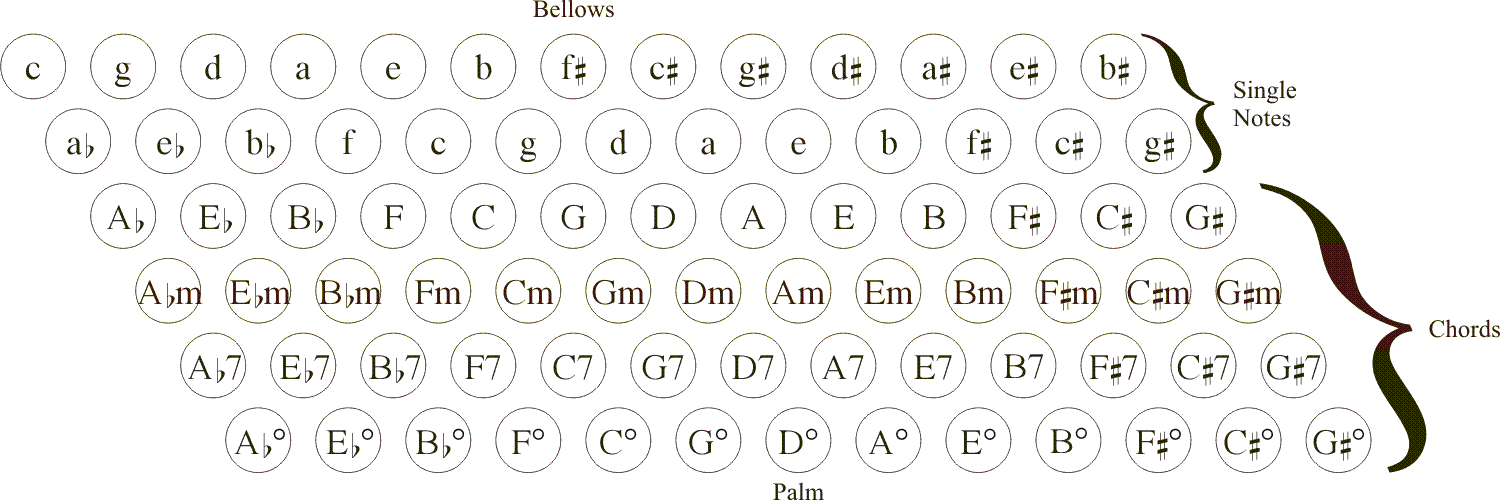I am planning to learn accordion and I am very much a beginner to the music world. I am wondering how accordion bass buttons are arranged. Is it possible to generate all different sets of chords using bass button or can we make a fixed set of chords ? What are the different types of bass button arrangements ?
1 Answer
There are two primary types of accordion: stradella and free bass. Although free bass accordions are somewhat more common in the classical music world (and I’ve been told they are somewhat more common in Europe than in America), the stradella is the more common. There are even some accordions capable of switching between the two modes.
In a free bass accordion, all of the buttons are single notes. The specific range varies widely, but a range between 4 and 5 octaves is pretty common for 120-button accordions. This is the largest size accordion, and I’ve never seen a smaller free bass accordion. The notes are arranged chromatically, the available chords are only limited by the reach of the hand.
An example free bass accordion layout:
Image source. Image by Acon.
Huge thanks to Todd Wilcox for adding this image. As a note about the variability of specific ranges: the accordionist I’ve worked with that has a free bass accordion (actually a hybrid that can switch modes) has the E furthest to the right as its lowest note; the D#/Eb button in the 1st row doesn’t have any sound. It’s highest pitch is the A#/Bb in the second row almost all the way to the left. The remaining six buttons from B–D#/Eb don’t make sound. The point is, the full range can’t be assumed for all free bass accordions.
A stradella accordion is more complicated. The largest, 120-button type looks the same as a free bass: 6 rows that are 20 buttons long. The first two rows (closest to the bellows) are the counterbass and bass rows respectively. Both rows produce single notes that traverse the circle of fifths, but the counterbass row is a major third above the corresponding button in the bass row. The C button in the bass row near the center is specially marked with a bump so you can find it by feel. Immediately above this C button is an F, then a Bb, etc. Immediately below this C button is a G then a D, etc. In the counterbass row right next to that bass row C button is an E. Going up from that E in the counterbass row gives you A, then D etc. and below gives you B and F# etc.
The remain four rows are the chord buttons, and they are always built on the same root as the corresponding bass row note. The first chord row is major triads, the second chord row is minor triads, the third row is dominant seventh chords (minus 5th) and the last chord row is fully-diminished seventh (also minus the 5th). So right next to that central C button is a CM chord, a Cm chord, a C7 chord and a Cdim7 chord. Every bass note has the complete series of chords, and every possible pitch is available (in several places) so all possible major, minor, dom7 and dim7 chord is possible. Smaller stradella accordions definitely exist, and what buttons are missing can range from completely eliminating some chord types and/or bass notes all the way to merely eliminating a few redundancies, so this is definitely something to be on the lookout for when buying one.
The specific octaves and voicings of all of these bass notes and chords depend on what stops are being used. Stops are similar to an organ and involving opening and closing different octaves and types of reeds. These vary massively from accordions to accordion—both free bass and stradella—so I won’t try to summarize them here.
Here's an example Stradella layout, although this is only a 78-button accordion. The full 120-key layout has two more columns on the right side and five more on the left. In other words, the exact same left-to-right range as in the image above all the way from Bbb–A# in the bass and chord rows. One last note on the following image: the final chord rows are actually diminished seventh chords rather than triads. Actually it’s even more complicated than that—since the fifth is omitted they could actually be thought of as diminished triads with a root a minor third below the specified root. Anyway, otherwise a very useful image:
Image source. Image by Theodore Kloba.
-
1@ToddWilcox Fantastic edit thanks! I’m going to add a couple of notes to your images, especially making note that this particular stradella layout is just for a 78-button. Commented Apr 22, 2018 at 18:48


